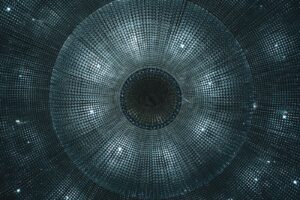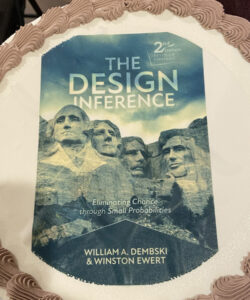Intelligent design begins with a seemingly innocuous question: Can objects, even if nothing is known about how they arose, exhibit features that reliably signal the action of an intelligent cause? To see what’s at stake, consider Mount Rushmore. The evidence for Mount Rushmore’s design is direct—eyewitnesses saw the sculptor Gutzon Borglum spend the better part of his life designing and building this structure. But what if there were no direct evidence for Mount Rushmore’s design? What if humans went extinct and aliens, visiting the earth, discovered Mount Rushmore in substantially the same condition as it is now?
In that case, what about this rock formation would provide convincing circumstantial evidence that it was due to a designing intelligence and not merely to wind and erosion? Designed objects like Mount Rushmore exhibit characteristic features or patterns that point to an intelligence. Such features or patterns constitute signs of intelligence. Proponents of intelligent design, known as design theorists, purport to study such signs formally, rigorously, and scientifically. Intelligent design may therefore be defined as the science that studies signs of intelligence.
Because a sign is not the thing signified, intelligent design does not presume to identify the purposes of a designer. Intelligent design focuses not on the designer’s purposes (the thing signified) but on the artifacts resulting from a designer’s purposes (the sign). What a designer intends or purposes is, to be sure, an interesting question, and one may be able to infer something about a designer’s purposes from the designed objects that a designer produces. Nevertheless, the purposes of a designer lie outside the scope of intelligent design. As a scientific research program, intelligent design investigates the effects of intelligence and not intelligence as such.
Intelligent design is controversial because it purports to find signs of intelligence in nature, and specifically in biological systems. According to the evolutionary biologist Francisco Ayala, Darwin’s greatest achievement was to show how the organized complexity of organisms could be attained apart from a designing intelligence. Intelligent design therefore directly challenges Darwinism and other naturalistic approaches to the origin and evolution of life.
The idea that an intrinsic intelligence or teleology inheres in and is expressed through nature has a long history and is embraced by many religious traditions. The main difficulty with this idea since Darwin’s day, however, has been to discover a conceptually powerful formulation of design that can fruitfully advance science. What has kept design outside the scientific mainstream since the rise of Darwinism has been the lack of precise methods for distinguishing intelligently caused objects from unintelligently caused ones.
For design to be a fruitful scientific concept, scientists have to be sure that they can reliably determine whether something is designed. Johannes Kepler, for instance, thought the craters on the moon were intelligently designed by moon dwellers. We now know that the craters were formed by purely material factors (like meteor impacts). This fear of falsely attributing something to design, only to have it overturned later, has hindered design from entering the scientific mainstream. But design theorists argue that they now have formulated precise methods for discriminating designed from undesigned objects. These methods, they contend, enable them to avoid Kepler’s mistake and reliably locate design in biological systems.
As a theory of biological origins and development, intelligent design’s central claim is that only intelligent causes adequately explain the complex, information-rich structures of biology and that these causes are empirically detectable. To say intelligent causes are empirically detectable is to say there exist well-defined methods that, based on observable features of the world, can reliably distinguish intelligent causes from undirected natural causes. Many special sciences have already developed such methods for drawing this distinction—notably forensic science, cryptography, archeology, and the search for extraterrestrial intelligence (SETI). Essential to all these methods is the ability to eliminate chance and necessity.
Astronomer Carl Sagan wrote a novel about SETI called Contact, which was later made into a movie. The plot and the extraterrestrials were fictional, but Sagan based the SETI astronomers’ methods of design detection squarely on scientific practice. Real-life SETI researchers have thus far failed to conclusively detect designed signals from distant space, but if they encountered such a signal, as the film’s astronomers’ did, they too would infer design. Why did the radio astronomers in Contact draw such a design inference from the signals they monitored from space? SETI researchers run signals collected from distant space through computers programmed to recognize preset patterns. These patterns serve as a sieve. Signals that do not match any of the patterns pass through the sieve and are classified as random.
After years of receiving apparently meaningless, random signals, the Contact researchers discovered a pattern of beats and pauses that corresponded to the sequence of all the prime numbers between two and one-hundred and one. (Prime numbers are divisible only by themselves and by one.) That startled the astronomers, and they immediately inferred an intelligent cause. When a sequence begins with two beats and then a pause, three beats and then a pause, and continues through each prime number all the way to one-hundred and one beats, researchers must infer the presence of an extraterrestrial intelligence.
Here’s the rationale for this inference: Nothing in the laws of physics requires radio signals to take one form or another. The prime sequence is therefore contingent rather than necessary. Also, the prime sequence is long and hence complex. Note that if the sequence were extremely short and therefore lacked complexity, it could easily have happened by chance. Finally, the sequence was not merely complex but also exhibited an independently given pattern or specification (it was not just any old sequence of numbers but a mathematically significant one—the prime numbers).
Intelligence leaves behind a characteristic trademark or signature—what within the intelligent design community is now called specified complexity. An event exhibits specified complexity if it is contingent and therefore not necessary; if it is complex and therefore not readily repeatable by chance; and if it is specified in the sense of exhibiting an independently given pattern. Note that a merely improbable event is not sufficient to eliminate chance—by flipping a coin long enough, one will witness a highly complex or improbable event. Even so, one will have no reason to attribute it to anything other than chance.
The important thing about specifications is that they be objectively given and not arbitrarily imposed on events after the fact. For instance, if an archer fires arrows at a wall and then paints bull’s-eyes around them, the archer imposes a pattern after the fact. On the other hand, if the targets are set up in advance (“specified”), and then the archer hits them accurately, one legitimately concludes that it was by design.
The combination of complexity and specification convincingly pointed the radio astronomers in the movie Contact to an extraterrestrial intelligence. Note that the evidence was purely circumstantial—the radio astronomers knew nothing about the aliens responsible for the signal or how they transmitted it. Design theorists contend that specified complexity provides compelling circumstantial evidence for intelligence. Accordingly, specified complexity is a reliable empirical marker of intelligence in the same way that fingerprints are a reliable empirical marker of an individual’s presence. Moreover, design theorists argue that purely material factors cannot adequately account for specified complexity.
In determining whether biological organisms exhibit specified complexity, design theorists focus on identifiable systems (e.g., individual enzymes, metabolic pathways, and molecular machines). These systems are not only specified by their independent functional requirements but also exhibit a high degree of complexity.
In Darwin’s Black Box, biochemist Michael Behe connects specified complexity to biological design through his concept of irreducible complexity. Behe defines a system as irreducibly complex if it consists of several interrelated parts for which removing even one part renders the system’s basic function unrecoverable. For Behe, irreducible complexity is a sure indicator of design. One irreducibly complex biochemical system that Behe considers is the bacterial flagellum. The flagellum is an acid-powered rotary motor with a whip-like tail that spins at twenty-thousand revolutions per minute and whose rotating motion enables a bacterium to navigate through its watery environment.
Behe shows that the intricate machinery in this molecular motor—including a rotor, a stator, O-rings, bushings, and a drive shaft—requires the coordinated interaction of approximately forty complex proteins and that the absence of any one of these proteins would result in the complete loss of motor function. Behe argues that the Darwinian mechanism faces grave obstacles in trying to account for such irreducibly complex systems. In No Free Lunch, William Dembski shows how Behe’s notion of irreducible complexity constitutes a particular instance of specified complexity.
Once an essential constituent of an organism exhibits specified complexity, any design attributable to that constituent carries over to the organism as a whole. To attribute design to an organism one need not demonstrate that every aspect of the organism was designed. Organisms, like all material objects, are products of history and thus subject to the buffeting of purely material factors. Automobiles, for instance, get old and exhibit the effects of corrosion, hail, and frictional forces. But that doesn’t make them any less designed. Likewise design theorists argue that organisms, though exhibiting the effects of history (and that includes Darwinian factors such as genetic mutations and natural selection), also include an ineliminable core that is designed.
Intelligent design’s main tie to religion is through the design argument. Perhaps the best-known design argument is William Paley’s. Paley published his argument in 1802 in a book titled Natural Theology. The subtitle of that book is revealing: Evidences of the Existence and Attributes of the Deity, Collected from the Appearances of Nature. Paley’s project was to examine features of the natural world (what he called “appearances of nature”) and from there draw conclusions about the existence and attributes of a designing intelligence responsible for those features (whom Paley identified with the God of Christianity).
According to Paley, if one finds a watch in a field (and thus lacks all knowledge of how the watch arose), the adaptation of the watch’s parts to telling time ensures that it is the product of an intelligence. So too, according to Paley, the marvelous adaptations of means to ends in organisms (like the intricacy of the human eye with its capacity for vision) ensure that organisms are the product of an intelligence. The theory of intelligent design updates Paley’s watchmaker argument in light of contemporary information theory and molecular biology, purporting to bring this argument squarely within science.
In arguing for the design of natural systems, intelligent design is more modest than the design arguments of natural theology. For natural theologians like Paley, the validity of the design argument did not depend on the fruitfulness of design-theoretic ideas for science but on the metaphysical and theological mileage one could get out of design. A natural theologian might point to nature and say, “Clearly, the designer of this ecosystem prized variety over neatness.” A design theorist attempting to do actual design-theoretic research on that ecosystem might reply, “Although that’s an intriguing theological possibility, as a design theorist I need to keep focused on the informational pathways capable of producing that variety.”
In his Critique of Pure Reason, Immanuel Kant claimed that the most the design argument can establish is “an architect of the world who is constrained by the adaptability of the material in which he works, not a creator of the world to whose idea everything is subject.” Far from rejecting the design argument, Kant objected to overextending it. For Kant, the design argument legitimately establishes an architect (that is, an intelligent cause whose contrivances are constrained by the materials that make up the world), but it can never establish a creator who originates the very materials that the architect then fashions.
Intelligent design is entirely consonant with this observation by Kant. Creation is always about the source of being of the world. Intelligent design, as the science that studies signs of intelligence, is about arrangements of preexisting materials that point to a designing intelligence. Creation and intelligent design are therefore quite different. One can have creation without intelligent design and intelligent design without creation. For instance, one can have a doctrine of creation in which God creates the world in such a way that nothing about the world points to design. The evolutionary biologist Richard Dawkins wrote a book titled The Blind Watchmaker: Why the Evidence of Evolution Reveals a Universe without Design. Even if Dawkins is right about the universe revealing no evidence of design, it would not logically follow that it was not created. It is logically possible that God created a world that provides no evidence of design. On the other hand, it is logically possible that the world is full of signs of intelligence but was not created. This was the ancient Stoic view, in which the world was eternal and uncreated, and yet a rational principle pervaded the world and produced marks of intelligence in it.
The implications of intelligent design for religious belief are profound. The rise of modern science led to a vigorous attack on all religions that treat purpose, intelligence, and wisdom as fundamental and irreducible features of reality. The high point of this attack came with Darwin’s theory of evolution. The central claim of Darwin’s theory is that an unguided material process (random variation and natural selection) could account for the emergence of all biological complexity and order. In other words, Darwin appeared to show that the design in biology (and, by implication, in nature generally) was dispensable. By showing that design is indispensable to the scientific understanding of the natural world, intelligent design is reinvigorating the design argument and at the same time overturning the widespread misconception that the only tenable form of religious belief is one that treats purpose, intelligence, and wisdom as byproducts of unintelligent material processes.
Bibliography
Beckwith, Francis J. Law, Darwinism, and Public Education: The Establishment Clause and the Challenge of Intelligent Design. Lanham, Md., 2003.
Behe, Michael J. Darwin’s Black Box: The Biochemical Challenge to Evolution. New York, 1996.
Dawkins, Richard. The Blind Watchmaker: Why the Evidence of Evolution Reveals a Universe without Design. New York, 1986.
Dembski, William A. No Free Lunch: Why Specified Complexity Cannot Be Purchased without Intelligence. Lanham, Md., 2002.
Forrest, Barbara. “The Wedge at Work: How Intelligent Design Creationism Is Wedging Its Way into the Cultural and Academic Mainstream.” In Intelligent Design Creationism and Its Critics: Philosophical, Theological, and Scientific Perspectives, edited by Robert T. Pennock, pp. 5–53, Cambridge, Mass., 2001.
Giberson, Karl W. and Donald A. Yerxa. Species of Origins: America’s Search for a Creation Story. Lanham, Md., 2002.
Hunter, Cornelius G. Darwin’s God: Evolution and the Problem of Evil. Grand Rapids, Mich., 2002.
Manson, Neil A., ed. God and Design: The Teleological Argument and Modern Science. London, 2003.
Miller, Kenneth R. Finding Darwin’s God: A Scientist’s Search for Common Ground between God and Evolution. San Francisco, 1999.
Rea, Michael C. World without Design: The Ontological Consequences of Naturalism. Oxford, 2002.
Witham, Larry. By Design: Science and the Search for God. San Francisco, 2003.
Woodward, Thomas. Doubts about Darwin: A History of Intelligent Design. Grand Rapids, Mich., 2003.
Bibliographic Essay
Larry Witham provides the best overview of intelligent design, even-handedly treating its scientific, cultural, and religious dimensions. As a journalist, Witham has personally interviewed all the main players in the debate over intelligent design and allows them to tell their story. For intelligent design’s place in the science and religion dialogue, see Giberson and Yerxa. For histories of the intelligent design movement, see Woodward (a supporter) and Forrest (a critic). See Behe and Dembski to overview intelligent design’s scientific research program. For a critique of that program, see Miller. For an impassioned defense of Darwinism against any form of teleology or design, see Dawkins. Manson’s anthology situates intelligent design within broader discussions about teleology. Rea probes intelligent design’s metaphysical underpinnings. Hunter provides an interesting analysis of how intelligent design and Darwinism play off the problem of evil. Beckwith examines whether intelligent design is inherently religious and thus, on account of church-state separation, must be barred from public school science curricula.
William A. Dembski
Baylor University


